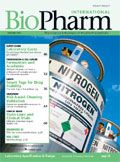Form Fluidly Follows Function
In the fast-changing pharmaceutical industry, adaptable planning provides a competitive edge.
Last year's catastrophic flu vaccine shortage and escalating congressional debate over drug safety continue to shine the spotlight on biotech product manufacturing. A constant balance must be achieved between cost-conscious drug development, pressure to meet quality, FDA-approved biotech products, and development of new treatments to meet patient needs, according to Jill Wechsler's "Regulatory Beat" column found in the June 2005 issue of BioPharm International.

Mr. Farach
To ensure patient access to consistently high-quality biotech therapies, the Center for Biological Evaluation and Research (CBER) sponsored a workshop on opportunities for collaboration with industry and other stakeholders in October of 2004 under the FDA's "Critical Path" initiative. Through this collaborative approach, CBER officials emphasize and encourage the value of discussing critical manufacturing issues with sponsors early in the clinical-development process, especially for companies considering novel methods for scale-up, product sampling, manufacturing-process control, or compliance with current good manufacturing practices (cGMPs).
To remain a contender in the highly competitive field of biopharm development, CBER's message is clear: plan early and often. On the design side, form must follow function to remain profitable. Form must be consistently fluid in laboratory biotech development as function evolves throughout product development and production.
Because some products rapidly become blockbusters and others fizzle and are abruptly pulled from the market, pharmaceutical laboratories — whether for research, development, pilot or manufacturing — should be built with flexibility to fluctuate with the current product. Planning for 10 or even five years ahead can leave a laboratory sluggish in its ability to adapt to current market demands.

cGMP pilot facility for the development of a drug delivery system technology.
Design should be driven by the present operation, equipment, and infrastructure. At the same time, the laboratory owner must try to identify trends and design to accommodate processes for the future. The following are some best practices that planners at HDR, Inc. have found to help keep labs in the game.
RESEARCH LABS
The nature of the research will typically dictate the lab functions, whether chemistry, biology, or both. Providing a modular design is the most cost-effective design practice at this stage to allow future lab conversions and/or expansions.
Adding to the design complexity, lines often become blurred between research, development, pilot and manufacturing labs. While processes at each stage may be similar, the protocols involved are different, and typically are less stringent in the early stages.
Experts recommend beginning with research-quality design, and to incorporate protocols as early in the process as possible. As research advances and moves into the development stage, the facility is prepared to incorporate all required equipment and support systems.
DEVELOPMENT LABS
At this stage, it is recommended to tailor the design of the space to a particular project to gain efficiency. A development laboratory's objectives are defined more closely, and it may perform small-scale manufacturing; therefore, it must meet higher regulatory criteria than a research lab. However, this stage continues to be highly volatile. If a potential product is considered ineffective or not feasible in development, the lab's next project can be extremely different from the current one, and the lab must be rapidly adaptable for the next project.
It is best to build in sufficient flexibility to permit a change-out of equipment and space for infrastructure that supports the new systems. Designs should include:
- Modular casework, movable benches, or benches on wheels
- Demountable walls to adjust total area required for projects
- Appropriately sized space and adaptive infrastructure. Design for a basic utility load, but anticipate increased electrical loads, process gases, and plumbing. Interstitial space is ideal, but may be economically prohibitive. At the minimum, include higher floor-to-floor space to accommodate adjustments.
MANUFACTURING LAB
A manufacturing lab may perform the same or similar duties as a development lab. However, it typically:
- Is larger in size to accommodate distribution
- Must support more intensive use, i.e., 24/7 operations
- Requires increased redundancy in utility infrastructure
- Adjacencies are particularly important in manufacturing because efficiency is critical. Yet, for economic reasons, manufacturing facilities tend to be stand alone operations. Devel-opment staff, however, often perform troubleshooting during initial manufacturing. Thus, situating a manufacturing facility near development laboratories has the potential to provide crucial time-saving efficiencies.
OVERALL BEST PRACTICES
Several overreaching best practices hold throughout the life cycle of a lab:
- Best Practice: Design plug-and- play technology. From research to manufacturing, the gradual, constant evolution toward automation is a driver for flexible design. Designing plug-and-play systems is optimal for providing the ability to replace equipment and add or relocate utilities.
- Best Practice: Identify lab protocols early for eventual cGMP-readiness. The sooner a research lab assimilates protocols and procedures that will be required at future phases, the fewer missteps, the shorter the learning curve for clinicians and the faster the product gets to market. Use of Laboratory Information Manage-ment Systems (LIMS) is highly recommended in standardizing work patterns and regulating processes. LIMS often are credited with streamlining the process for achieving cGMP status.
- Best Practice: Segregate mechan-ical/electical/plumbing systems. Follow strict segregation of air-circulation systems between research and other facilities. Otherwise, the space may not be cGMP-compliant when converting to manufacturing, and validation may be time-consuming and costly to attain.
THE HUMAN ELEMENT
- Best Practice: Plan activities and spaces to bring people together. Scientists tend to have isolated work habits. Introduce a central informal gathering space, a "fellow's room," or a theme lunch to create a vehicle for social interaction among researchers and scientists. A room with shared workstations may increase exchanges of information among and across disciplines.
- Best Practice: Create stress-free spaces. In some labs, protocols can be so strict that the physical environment can be sterile and stressful for staff who must occupy them for long periods of time. Include comforting areas and amenities such as natural light-ing, nature views, comfortable furnishings, coffee bar, vending machines/magazines/newspapers, bulletin board, an audio/music sound system, decorative artwork, and a video/entertainment system. Also, if part of a larger facility, it may be a good idea to incorporate cafeteria food service. In other words, a place to socialize and daydream that allows researchers to break away from their work can help to renew creativity.
CONCLUSION
Over- and under-designed laboratories lead to inefficiencies and increased costs. It is important to design for current processes but to also anticipate future needs — and to build in flexibility to adapt quickly to unanticipated circumstances. On the surface, processes may be similar, but protocols actually may be different. Through collaboration, as CBER recommends, and through identifying the protocols early in the process, pharmaceutical laboratories can deliver consistently high-quality products and maintain their competitive edge. Most importantly, form must fluidly follow function in the fast-changing, fiercely competitive biopharmaceutical world.
Mr. Farach is a laboratory/facility planner for HDR, Inc., 8404 Indian Hills Drive, Omaha, NE 68114,Tel: 916. 817.4700, Fax: 916.817.4747, martin.farach@hdrinc.com Clarence Lind, MBA, AIA, is a project manager for HDR, Inc., 402.399.1345, Clarence.Lind@hdrinc.com

Mastering Antibody-Drug Conjugates
December 19th 2024In this episode, we explore BIOVECTRA’s capabilities in antibody-drug conjugate (ADC) manufacturing, from complex conjugation chemistry to synthesis of highly potent payloads. We’ll also showcase how BIOVECTRA’s extensive experience in complex chemistries and specialized small molecule manufacturing gives them a unique perspective, strengthening their approach to ADC production and ensuring clients receive custom solutions across all project stages.
Filter Sizing for Process Optimization in Life Sciences Sterile Filtration
April 24th 2025Bench-scale filterability studies play a critical role in optimizing sterile filtration in biopharmaceutical manufacturing. By guiding the selection and sizing of filters, these studies help streamline processes, improve scalability, and reduce costs. Through data-driven case studies, this paper highlights how the strategic use of pre-filters and membrane materials can maximize throughput and minimize filter fouling.
VERAXA and Voyager to Create Combined Business for Advancing Pipeline of Next-Gen Cancer Therapies
April 23rd 2025The proposed business combination would create a publicly traded, clinical-stage biopharmaceutical company that will focus on developing a pipeline of next-generation cancer therapies.